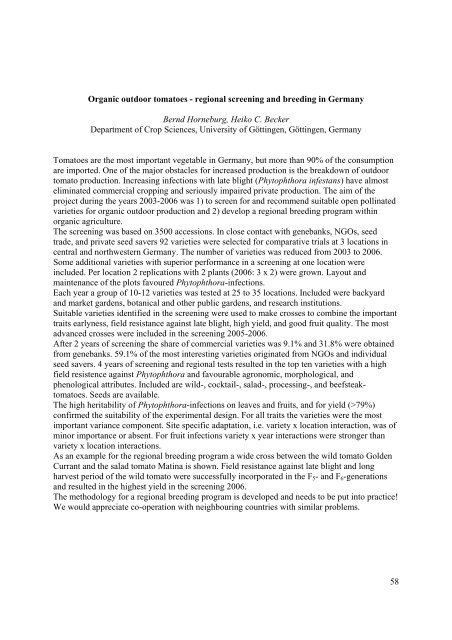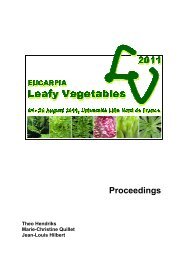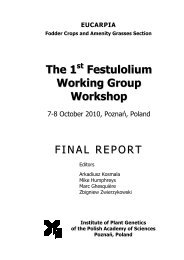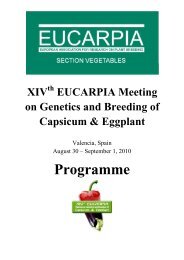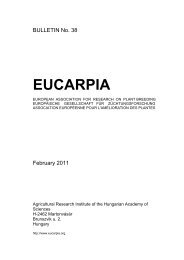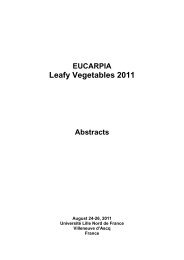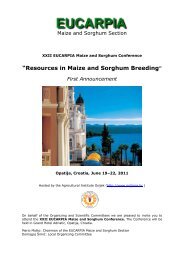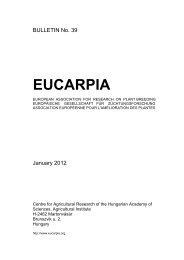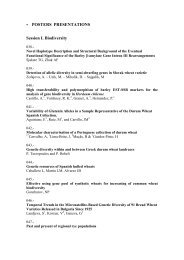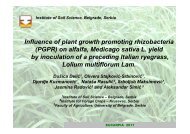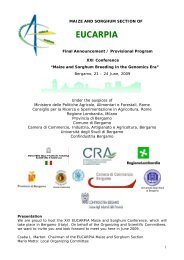Plant breeding for organic and sustainable, low-input agriculture
Plant breeding for organic and sustainable, low-input agriculture
Plant breeding for organic and sustainable, low-input agriculture
You also want an ePaper? Increase the reach of your titles
YUMPU automatically turns print PDFs into web optimized ePapers that Google loves.
Organic outdoor tomatoes - regional screening <strong>and</strong> <strong>breeding</strong> in Germany<br />
Bernd Horneburg, Heiko C. Becker<br />
Department of Crop Sciences, University of Göttingen, Göttingen, Germany<br />
Tomatoes are the most important vegetable in Germany, but more than 90% of the consumption<br />
are imported. One of the major obstacles <strong>for</strong> increased production is the breakdown of outdoor<br />
tomato production. Increasing infections with late blight (Phytophthora infestans) have almost<br />
eliminated commercial cropping <strong>and</strong> seriously impaired private production. The aim of the<br />
project during the years 2003-2006 was 1) to screen <strong>for</strong> <strong>and</strong> recommend suitable open pollinated<br />
varieties <strong>for</strong> <strong>organic</strong> outdoor production <strong>and</strong> 2) develop a regional <strong>breeding</strong> program within<br />
<strong>organic</strong> <strong>agriculture</strong>.<br />
The screening was based on 3500 accessions. In close contact with genebanks, NGOs, seed<br />
trade, <strong>and</strong> private seed savers 92 varieties were selected <strong>for</strong> comparative trials at 3 locations in<br />
central <strong>and</strong> northwestern Germany. The number of varieties was reduced from 2003 to 2006.<br />
Some additional varieties with superior per<strong>for</strong>mance in a screening at one location were<br />
included. Per location 2 replications with 2 plants (2006: 3 x 2) were grown. Layout <strong>and</strong><br />
maintenance of the plots favoured Phytophthora-infections.<br />
Each year a group of 10-12 varieties was tested at 25 to 35 locations. Included were backyard<br />
<strong>and</strong> market gardens, botanical <strong>and</strong> other public gardens, <strong>and</strong> research institutions.<br />
Suitable varieties identified in the screening were used to make crosses to combine the important<br />
traits earlyness, field resistance against late blight, high yield, <strong>and</strong> good fruit quality. The most<br />
advanced crosses were included in the screening 2005-2006.<br />
After 2 years of screening the share of commercial varieties was 9.1% <strong>and</strong> 31.8% were obtained<br />
from genebanks. 59.1% of the most interesting varieties originated from NGOs <strong>and</strong> individual<br />
seed savers. 4 years of screening <strong>and</strong> regional tests resulted in the top ten varieties with a high<br />
field resistence against Phytophthora <strong>and</strong> favourable agronomic, morphological, <strong>and</strong><br />
phenological attributes. Included are wild-, cocktail-, salad-, processing-, <strong>and</strong> beefsteaktomatoes.<br />
Seeds are available.<br />
The high heritability of Phytophthora-infections on leaves <strong>and</strong> fruits, <strong>and</strong> <strong>for</strong> yield (>79%)<br />
confirmed the suitability of the experimental design. For all traits the varieties were the most<br />
important variance component. Site specific adaptation, i.e. variety x location interaction, was of<br />
minor importance or absent. For fruit infections variety x year interactions were stronger than<br />
variety x location interactions.<br />
As an example <strong>for</strong> the regional <strong>breeding</strong> program a wide cross between the wild tomato Golden<br />
Currant <strong>and</strong> the salad tomato Matina is shown. Field resistance against late blight <strong>and</strong> long<br />
harvest period of the wild tomato were successfully incorporated in the F5- <strong>and</strong> F6-generations<br />
<strong>and</strong> resulted in the highest yield in the screening 2006.<br />
The methodology <strong>for</strong> a regional <strong>breeding</strong> program is developed <strong>and</strong> needs to be put into practice!<br />
We would appreciate co-operation with neighbouring countries with similar problems.<br />
58


